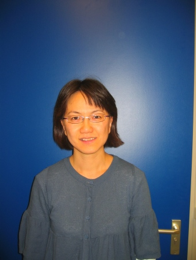From supra-molecular chemistry to nanotechnology: assembly of 3D nanostructures
Promotion date: 24. October 2008
Thesis advisors: Prof. dr. ir. David Reinhoudt, Prof. dr. ir. Jurriaan Huskens
| This thesis aims to construct stable, ordered and functional 2D and 3D nanoparticle structures. Molecular recognition abilities have been exploited by using a combination of supra-molecularly directed self-assembly of receptor-functionalized nanoparticles, and top-down nanofabrication techniques. Self-assembly of nanoparticles, templating, and supramolecular chemistry were combined to obtain stable and ordered free-standing 3D nanoparticle structures and capsules, using also “supramolecular glues”. |
Was there a special moment during your thesis project at MESA+?
I can remember that moment very well. It was at the end of last year. Using the electron microscope I could clearly identify the stable properties of the particle bridge I build. The bridge was about five micrometers long, consisting of nearly a hundred particles, resting on two supportive points of a pre-treated substrate.
Before reaching this point, it was hard work?
Well, it took a long time, you could say. The early stages of the project were more fundamentally oriented. The project developed in a steady way, and eventually I obtained some fascinating results in the later stages. When the building of the bridge succeeded, I felt somewhat relieved. It was a like a natural end-point.
Is this result still quite fundamental, or are applications already visible?
I was able to conclude, that 3D nanoparticle structures are ready to be used as 3D receptors for the application in sensing devices. The recognition function of the individual nanoparticles can be further engineered as a sensing tool in the subsequent assembly of complementary guest molecules of nano-objects.
In the future these structures can find their way in photonic crystals or even in optical devices, I believe.
How did you ‘find’ the MESA+ institute, to continue your career as a researcher?
My husband and I were both looking for PhD-opportunities at the time, in Singapore, where we lived. We were both very lucky. There were possibilities at MESA+, and when we checked the institute we were very excited about all the disciplines present, grouped together under one roof.
We both started on the same day, here at MESA+, my husband working at the Materials Science & Technology of Polymers. And - what is even more special - we both finish on the same date as well. Immediately after my promotion meeting, his final presentation takes place.
Do you have any future plans already, in Holland or elsewhere?
At first I am continuing here in a short post-doc project. I really like research. I dare not think of a big academic career already. Perhaps a next step can be with a research institute, or at a R&D-division in a big company.
This can be everywhere in the world, really. My husband and I are looking for an interesting change of environment, after four years in Twente. I got used to moving. Already since my secondary school, I live independently of my parents. This was not easy at the time, when I was only thirteen years old. But now, I can go everywhere.
What, you think, will MESA+ be like in five years from now?
I hope they will be the same! Nanotechnology is neither physics, nor chemistry, nor biology. You really need all expertises at once. People here are always willing to share their expertise with you, in a friendly way. When you send an email, you always get a reply.
For me personally, the training capabilities I build up here were great. I couldn’t ask for more. Especially the support in using cleanroom facilities, the building of devices, and using the electron microscope, were excellent.

